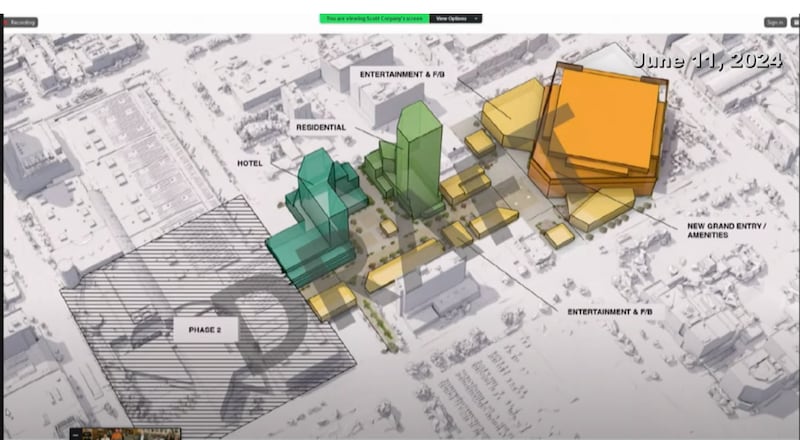The Smith Entertainment Group revealed more of its plans Tuesday to make over downtown Salt Lake City in the area around the Delta Center as part of an effort to ensure the urban core is vibrant well into the future.
The proposed project includes an east-facing entrance to the Delta Center, several pedestrian plazas, an outdoor television screen, taking 300 West, which runs in front of the arena, underground between 100 South and South Temple, and building a residential tower and a hotel. The plan also calls for remodeling the arena to accommodate both the NBA’s Utah Jazz and Utah’s new NHL team. Jazz owner Ryan Smith bought the Arizona Coyotes and moved the franchise to Salt Lake City in April.
“This is not a sports and entertainment district,” Mike Maughan, a principal in SEG, told the Salt Lake City Council in a meeting Tuesday. “This is a sports, entertainment, culture and convention district. I think the reason that’s so important to point out is that it fundamentally changes the make-up of what we’re doing, why we’re doing it and how it all comes together.”
SEG has said it intends to invest $3 billion in the project. Maughan said that if everything comes together, renovations of the Delta Center would start next April. The timeline for everything else would be coordinated with Salt Lake City and Salt Lake County. The future of Abravanel Hall, which is operated by Salt Lake County, and redesigning the Salt Palace Convention Center weren’t part of the proposals he presented to the council, but he said would be considered in phase two.
Maughan said the city, county and state need to collaborate to make it happen.
“A lot of things have to come together,” he said. “For us, before we move a single brick, we need to make sure that everyone is taken care of. Our worst-case scenario is that we go remodel the arena and create this amazing arena and nothing else changes downtown.”
Council Chairwoman Victoria Petro said the plans are conceptual at this point.
“Nothing is set in stone,” she said.

Assessing a sales tax increase
Earlier this year, the Utah Legislature, with Salt Lake City and Salt Lake County support, passed legislation allowing the creation of a downtown revitalization zone. Under the law, the city could raise its current 7.75% sales tax rate one-half of a percent — pushing it to 8.25% over no more than 30 years to help remodel the arena. The citywide tax increase could generate in the neighborhood of $900 million.
Natale Gochnour, an economist and director of the Kem C. Gardner Policy Institute, told the council that 75% to 80% of the sales tax is paid by businesses and nonresidents of Salt Lake City. Also, the tax doesn’t apply to groceries and major purchases like vehicles. Salt Lake City residents, she said, benefit for $3 out of every $4 that are invested from the sales tax proposal.
“And what do they get for it? They get a vibrant, growing, thriving, dynamic city that has upward mobility,” she said.
Gochnour also estimated that Salt Lake City households would on average pay about $120 to $150 a year in additional sales tax. But, she said, the amount really depends on how much people consume. Some might pay $1,000 more, while others only $20, she said.
Council members spent little time talking about the tax increase during the meeting. They are scheduled to vote on whether to raise the tax next month. But overall, the council appears to favor moving forward.
“I really think we have something magical here for everyone,” council member Alejandro Puy said.
A gathering place
Maughan said the company wants to make sure there are benefits for residents even if they never buy a ticket to a basketball or hockey game or the symphony or attend a convention. Those would include making the city safe and more walkable and restoring the connectivity and flow between the east and west sides of downtown, he said.
“The goal overall is to create a very family-friendly gathering space, many family-friendly gathering spaces, downtown where people can shop, eat, gather and come together,” he said. The plazas could host events such as festivals, watch parties on the big screen and Olympic medals presentations, Maughan said.
SEG also wants to build “complementary” retail such as NBA and NHL team stores. “We’re not building another mall here,” he said. Maughan also made it clear that SEG has never asked for and has no intention of asking for a helipad downtown.
Reviving downtown
Maughan said even without hockey and basketball, downtown needs revitalization.
“This gives us the opportunity to do it all at once in a cohesive, collaborative, well-thought-out way, that creates a bit of a master plan for downtown instead of a piecemeal plan,” he said. “All of that work needs to be done anyway.”
Gochnour told the council that sports, entertainment, culture and conventions are vital to keeping downtown vibrant.
“If you let those go, if the urban core declines because of their departure, it creates a vicious cycle and it’s very difficult to get out of it,” she said. “The economic forces of decentralization pull people, jobs and commerce away from the core. Sports, entertainment, culture and conventions bring them back.”
Gochnour said the project should be viewed as an investment, not a subsidy. A bustling downtown attracts talented people to the workforce and becomes a major economic driver for the area, she said. The economic goal isn’t entertainment, she said, but human capital.
“I think it’s a really important moment in our city’s history,” Gochnour said. “We still got a chance of holding onto a great American city because of investment.”

